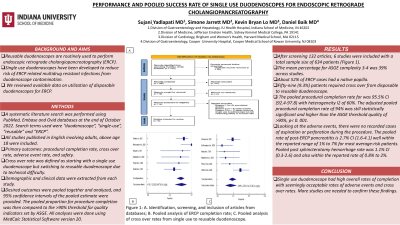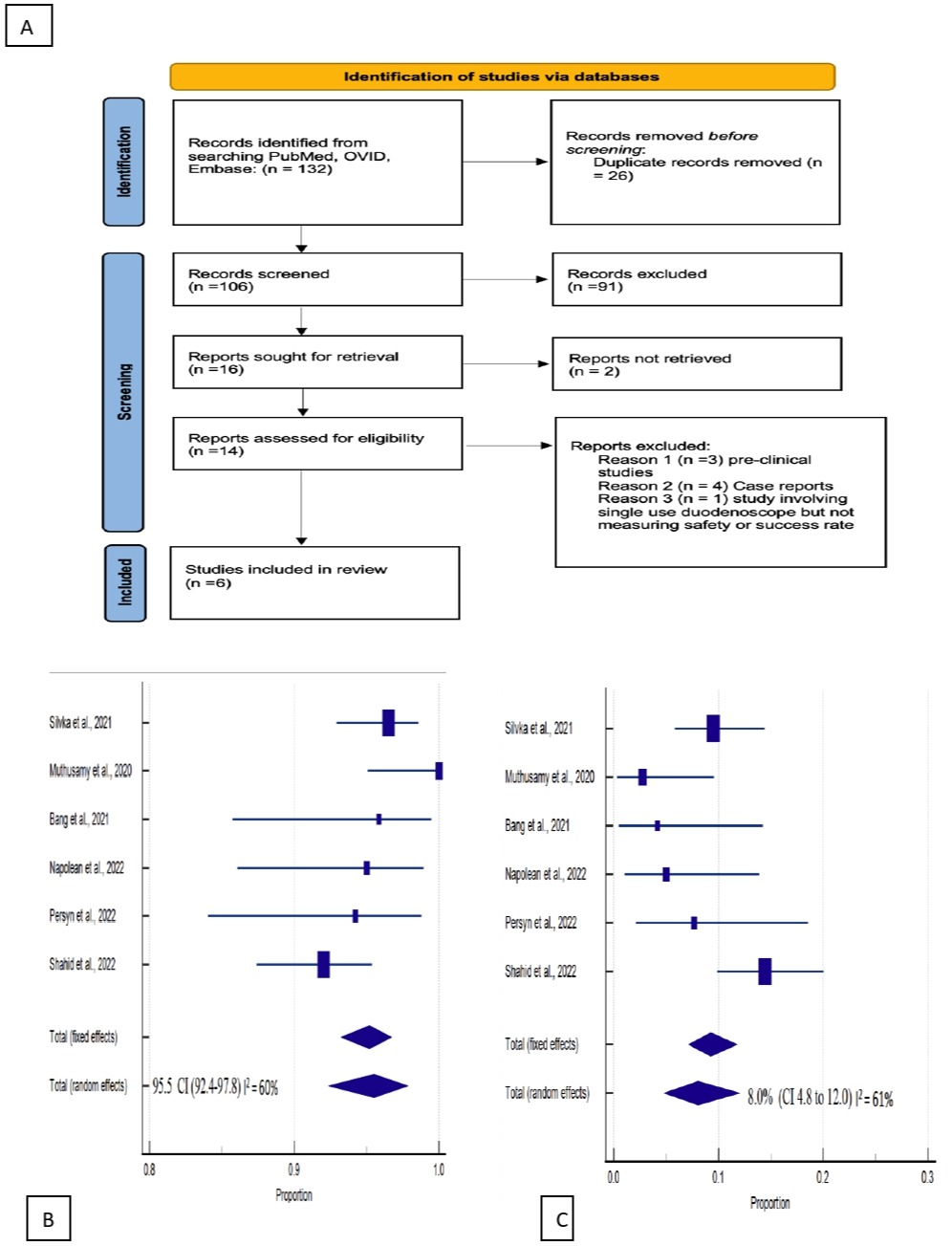Tuesday Poster Session
Category: Interventional Endoscopy
P3717 - Performance and Pooled Success Rate of Single Use Duodenoscopes for Endoscopic Retrograde Cholangiopancreatography
Tuesday, October 24, 2023
10:30 AM - 4:00 PM PT
Location: Exhibit Hall

Has Audio
- SY
Sujani Yadlapati, MD
Cooper Medical School of Rowan University/Cooper University Hospital
Camden, New Jersey
Presenting Author(s)
Sujani Yadlapati, MD1, Simone Jarrett, MD2, Kevin Lo, MD2, Daniel Baik, MD3
1Cooper Medical School of Rowan University/Cooper University Hospital, Camden, NJ; 2Albert Einstein Medical Center, Philadelphia, PA; 3Cooper University Health Care, Camden, NJ
Introduction: Single use duodenoscopes have been developed to reduce risk of ERCP related multidrug resistant infections from duodenoscope contamination. We reviewed available data on utilization of disposable duodenoscopes for ERCP.
Methods: A systematic literature search was performed using PubMed, Embase and Ovid databases at the end of October 2022. Search terms used were “duodenoscope”,” single-use”, “reusable” and “ERCP”. All studies published in English involving adults, above age 18, who underwent ERCP were included. The primary outcomes of interest were procedural completion rate, cross over rate, adverse event rate, and safety. Cross over rate was defined as starting with a single use duodenoscope but switching to reusable duodenoscope due to technical difficulty. Demographic and clinical data were extracted from each study. Desired outcomes were pooled together and analyzed, and 95% confidence intervals of the pooled estimate were provided. The pooled proportion for procedure completion was then compared to the >90% threshold for quality indicators set by ASGE. All analyses were done using MedCalc Statistical Software version 20.
Results: After screening 132 articles, 6 studies were included with a total sample size of 634 patients (Figure 1). The mean percentage for ASGE complexity 3-4 was 39% across studies. About 52% of ERCP cases had a native papilla. Fifty-nine (9.3%) patients required cross over from disposable to reusable duodenoscope. The pooled procedural completion rate for was 95.5% CI (92.4-97.8) with heterogeneity I2 of 60%. The adjusted pooled procedural completion rate of 94% was still statistically significant and higher than the ASGE threshold quality of >90%, p< 0. 001. Looking at the adverse events, there were no recorded cases of aspiration or perforation during the procedure. The pooled rate of post-ERCP pancreatitis is 2.7% CI (1.6-4.1) well within the reported range of 1% to 7% for most average-risk patients. Pooled post sphincterotomy hemorrhage rate was 1.1% CI (0.3-2.6) and also within the reported rate of 0.8% to 2%.
Discussion: Single use duodenoscope had high overall rates of completion with seemingly acceptable rates of adverse events and cross over rates. More studies are needed to confirm these findings.

Disclosures:
Sujani Yadlapati, MD1, Simone Jarrett, MD2, Kevin Lo, MD2, Daniel Baik, MD3. P3717 - Performance and Pooled Success Rate of Single Use Duodenoscopes for Endoscopic Retrograde Cholangiopancreatography, ACG 2023 Annual Scientific Meeting Abstracts. Vancouver, BC, Canada: American College of Gastroenterology.
1Cooper Medical School of Rowan University/Cooper University Hospital, Camden, NJ; 2Albert Einstein Medical Center, Philadelphia, PA; 3Cooper University Health Care, Camden, NJ
Introduction: Single use duodenoscopes have been developed to reduce risk of ERCP related multidrug resistant infections from duodenoscope contamination. We reviewed available data on utilization of disposable duodenoscopes for ERCP.
Methods: A systematic literature search was performed using PubMed, Embase and Ovid databases at the end of October 2022. Search terms used were “duodenoscope”,” single-use”, “reusable” and “ERCP”. All studies published in English involving adults, above age 18, who underwent ERCP were included. The primary outcomes of interest were procedural completion rate, cross over rate, adverse event rate, and safety. Cross over rate was defined as starting with a single use duodenoscope but switching to reusable duodenoscope due to technical difficulty. Demographic and clinical data were extracted from each study. Desired outcomes were pooled together and analyzed, and 95% confidence intervals of the pooled estimate were provided. The pooled proportion for procedure completion was then compared to the >90% threshold for quality indicators set by ASGE. All analyses were done using MedCalc Statistical Software version 20.
Results: After screening 132 articles, 6 studies were included with a total sample size of 634 patients (Figure 1). The mean percentage for ASGE complexity 3-4 was 39% across studies. About 52% of ERCP cases had a native papilla. Fifty-nine (9.3%) patients required cross over from disposable to reusable duodenoscope. The pooled procedural completion rate for was 95.5% CI (92.4-97.8) with heterogeneity I2 of 60%. The adjusted pooled procedural completion rate of 94% was still statistically significant and higher than the ASGE threshold quality of >90%, p< 0. 001. Looking at the adverse events, there were no recorded cases of aspiration or perforation during the procedure. The pooled rate of post-ERCP pancreatitis is 2.7% CI (1.6-4.1) well within the reported range of 1% to 7% for most average-risk patients. Pooled post sphincterotomy hemorrhage rate was 1.1% CI (0.3-2.6) and also within the reported rate of 0.8% to 2%.
Discussion: Single use duodenoscope had high overall rates of completion with seemingly acceptable rates of adverse events and cross over rates. More studies are needed to confirm these findings.

Figure: Figure 1: A. Identification, screening, and inclusion of articles from databases; B. Pooled analysis of ERCP completion rate; C. Pooled analysis of cross over rates from single use to reusable duodenoscope.
Disclosures:
Sujani Yadlapati indicated no relevant financial relationships.
Simone Jarrett indicated no relevant financial relationships.
Kevin Lo indicated no relevant financial relationships.
Daniel Baik indicated no relevant financial relationships.
Sujani Yadlapati, MD1, Simone Jarrett, MD2, Kevin Lo, MD2, Daniel Baik, MD3. P3717 - Performance and Pooled Success Rate of Single Use Duodenoscopes for Endoscopic Retrograde Cholangiopancreatography, ACG 2023 Annual Scientific Meeting Abstracts. Vancouver, BC, Canada: American College of Gastroenterology.
